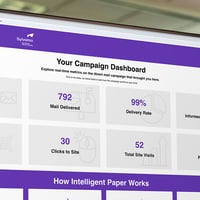What is the Difference Between Uncoated Paper and Digital Treated Paper?

You’ve likely heard the terms uncoated paper and digital treated paper before. They’re both pretty ubiquitous in the paper world, but even with how frequently they appear, there’s still a lack of clarity on the differences between the two — and the kinds of applications and presses that are ideal for each.
To help clear the confusion about uncoated paper — sometimes referred to as offset paper — and digital paper, let’s compare the two in terms of their traits and characteristics, and then look at what factors designers and printers should account for when deciding which type of paper to use for their project.
What is uncoated printing paper?
Uncoated paper is defined by a handful of important characteristics that make it very different from digital treated paper. First, uncoated paper lacks any kind of coating or treatment. This makes the sheets more porous and increases the level of ink absorption. The lack of coating can also make the paper feel more coarse and textured to the touch because the wood fibers are essentially exposed.
Because uncoated paper doesn’t use a coating, the texture of the sheet depends on how much the sheet is calendered, which is a process of passing the sheet through a series of rollers that use enough force to compress the fibers. A high degree of calendering makes an uncoated sheet extremely level and uniform, which can in turn help foster more consistent ink absorption and better image quality.
For more details, read our FAQ on uncoated paper.
What is digital treated paper?
Digital treated paper uses a coating, treatment or finish to blanket or seal the wood fibers so that the paper can perform better on digital presses. Digital treatments vary by digital press type but two common treatments are inkjet and Indigo.
Inkjet treated sheets are formulated to run on pigment and dye-based roll- and sheet-fed presses. Inkjet treated sheets – which are treated during the paper making process and carry the treatment in the fibers of the sheet as opposed to on top — provide the same brilliant color quality that is normally associated with coated sheets, but with a more traditional and authentic look of uncoated paper.
Inkjet inks are 95% water, and inkjet treatment helps to wick away the excess water so that the sheet can dry evenly. What’s more, inkjet treated sheets help create superior quality projects on high-speed inkjet presses while also using less ink than would be necessary with an untreated sheet.
Indigo treated sheets are specifically designed to run on HP® Indigo presses. Indigo treated paper offers a smooth, level surface that results in crisp, vivid images where the ink dries quickly and evenly. The Rochester Institute of Technology, an independent testing facility for HP Inc., uses a star rating system when certifying papers formulated for the Indigo, with three stars being the highest rating they give.
When to use uncoated versus digital treated sheets?
The answer to this question is all about the type of press you’re using, and whether that press is a good fit for uncoated or digital treated sheets in service of a quality end product.
If you’re printing on a small or large offset press, uncoated paper is the more apt choice because of its high degree of ink absorption, which makes the sheet more compatible with the plate-based method offset presses use to apply ink.
You can print an uncoated sheet on a digital inkjet press, but because the sheet is not properly treated, you may not be able to achieve the stunning color quality and clarity that is associated with digital inkjet print — especially if you’re using a dye-based ink, as an uncoated sheet will absorb the ink into the fibers and could bleed and become dull. (That said, digital press technologies are improving all the time, and the latest presses to hit the market can handle a much wider range of media than previous generations.)
When choosing a digital treated sheet, it’s important to make sure you’ve got the right one for your press. With inkjet, ink is applied to a sheet in small dots with all the colors being printed in a single pass. The inkjet treatment helps to prevent these small dots from spreading too far, which could hamper the clarity of your text. Indigo presses, on the other hand, lay the ink onto a blanket one color at a time, and then use a combination of heat and pressure to transfer the ink from the blanket to the paper. Indigo treated papers must be durable to withstand this process.
Which is right for your application: uncoated or digital treated paper?
Both uncoated paper and digital treated paper can be used for print materials such as perfect bound books, booklets, invoices, letterhead and other forms of conventional print communications, as well as more graphic applications like brochures, posters and catalogs. Both are available in heavier weights and stand up well to a variety of special finishes like foil stamping and die cutting, which are ideal for applications like direct mail.
If you are printing on a digital press, the question to ask yourself is: Do I need my text to be crisp and clear, and do I want my full-color images to be vibrant? If so, you’ll want to select a digital treated sheet that is specially formulated for your press and its ink type in order to get maximum on-press performance.
No matter what you’re trying to achieve in print, Accent can help. See how we can help you take your project to the next level of quality and innovation with our premium uncoated or digital treated paper.





